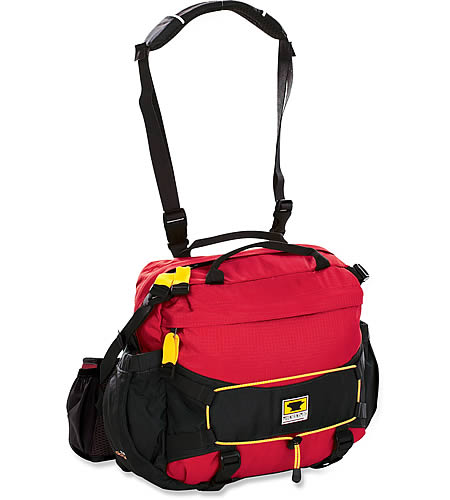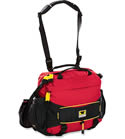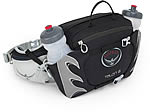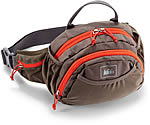Have you ever felt stupid taking a heavy day pack on a short hike? Or perhaps the opposite happened and you took a hike without a pack at all—only to discover the importance of water but had none to drink? Or perhaps you’ve become tired of having a smelly, sweaty back at the end of a hike? Or perhaps you just want to discover what true “ultralight day hiking” is all about?
 |
| A large Mountainsmith Waist Pack. More Info at REI.Com |
Well, if you fit into any of those categories (and many other potential categories, too), there’s good news. For many day hikers, waist packs—not day packs—are the ideal pack for day hiking.
But notice I said many people—not all. Waist packs aren’t for everyone. And they certainly aren’t for every type of day hike a person takes. Instead, waist packs are like any other type of hiking gear—they have specific uses they are ideally suited for. Using a waist pack on a hike that requires lots of water is a recipe for an unpleasant hike, at a minimum.
The purpose of this lengthy article is to help hikers determine whether they might enjoy using a waist pack for their day hikes. And, if so, what type of waist pack to buy and where to buy it.
This article covers the following topics:
What Is a Waist Pack?
A waist pack, also known as a "fanny pack," is basically a small "pack" that fits along the hiker's waist. Since the pack fits snugly around the hiker's waist, waist packs have limited cargo capacity.
Years ago, waist packs were rarely used day hiking. Seeing someone with a waist pack on a hiking trail was a rare sight. Today, though, waist packs are frequently used for short, medium and even longer hikes - and used on all varieties of hiking trails..
Waist packs are generally worn with the "pack" lying behind the hiker (the main compartment rests against the hiker's back). But for smaller waist packs, they can also be worn with the main compartment in front of the hiker.
Waist packs are ideally suited for shorter hikes in stable weather condtions.
Benefits of Waist Packs
After going many years ignoring waist packs—only using a small one to carry photography gear—I finally used a waist pack for a short hike, across flat terrain on a pleasant summer day. Following an enjoyable hike, I became a waist pack convert. Since then, I have bought five different waist packs—each which have specific uses.
Anyways, that’s my history with waist packs. Let’s dive into some of the benefits that waist packs provide in comparison to their larger, day pack cousins.
- Ultralight Weight – No day pack, regardless of how fancy it’s construction, possesses the ultralight weight of a waist pack.
- Keeps the Shoulders Happy – For me, this is the biggest benefit of using waist packs. Gone are the sore shoulders and the sometimes constant struggle with pack straps to keep the shoulders “happy.”
- Better Balance – Since waist packs ride along the waist, hiker’s have better balance compared with wearing a day pack. As a bonus, it is far easier to walk “upright and normal” when wearing a waist pack compared with day packs.
- Forces Minimalism – Even the largest waist packs have capacities of, at most, 800 cubic inches (the hiker carries their water bottles by inserting them in the elastic straps along the side of the waist pack). With such limited capacity, hikers need to choose what to bring on a hike. In short, hikers lack the cargo capacity to bring heavy books, needless clothing, monster first aid kits and other heavy, bulky items on the hike.
Instead, hikers should just leave those items back in the car or at home. And while going minimalism violates the Boy Scouts motto, I’ve found the “less I bring” on hikes the more I enjoy it. And by using small, compact multi-use items, hikers can stuff a surprising number of items inside even medium sized waist packs. - No More Stinky, Sweaty Backs – Day packs have improved significantly from just a decade ago. My Osprey day pack (the Talon) allows air flow along my back, helping dry out perspiration. Yet, that improved air flow pales still pales compared to having nothing on the back. Having a “dry and non-stinky” back is a large benefit of using waist packs.
The Drawbacks of Waist Packs
Waist packs provide a hiker with many benefits. Of course, waist packs also have drawbacks.
- Variable Weather Conditions – The lack of capacity with waist packs limits their ability to carry extra clothing beyond what the hiker wears. For short day hikes, this isn’t a big issue as the hiker just needs to dress correctly at the start of the hike.
However, for longer hikes—especially hikes where the weather might turn colder or rainy—a waist pack is a poor pack choice and potentially leaves the hiker exposed to inclement weather. While hiker’s can work around this problem by tying excess clothing around their waist, that isn’t a solution that all hiker’s enjoy (including myself). When I hike, if I know or suspect the weather might turn nasty, I’ll leave the waist pack home and use a day pack instead. - Longer Hikes Without Ability to Resupply Water – For longer hikes, or hikes in hot weather, a waist pack often can’t provide enough water storage capacity. Unless a hiker knows they’ll pass near a drinkable water source (or have a small water filter straw), the ability to hike long distances or to hike in hot weather using a waist pack is limited.
- Day Use Only – Many day packs, especially in this era of ultralight backpacking, can pull double duty and work well for short overnight hikes (1-3 nights out). Waist packs, by contrast, are ideal for shorter day hikes and lack the capacity or water storage for use on overnight trips. Of course, a hiker can use a waist pack on overnight trips to expand the capacity of a day pack.
- Heavy Loads and Waist Packs Don’t Mix – Designed to carry lighter weights, waist packs are poor packs to use if the hiker carries heavy items. Even two full 32 ounce bottles of water, combined with whatever else is stuffed inside the pack, will often “overload” a waist pack.
Most waist packs become uncomfortable and ride poorly if they carry more than five pounds of total weight (and that includes the weight of the water). Thus, if you know you’ll be carrying items (including water) that total more than five pounds, it is best to use a small day pack instead
The Four Types of Waist Packs
 Large Waist Pack – Roughly 600-800+ cubic inches of storage. Do not come with dedicated water bottles or water bottle holders. Instead, the hiker supplies their own water bottles and carries them by inserting the bottles through the elastic straps located along the side of the waist pack. Most large waist packs also come with a shoulder strap (or bought separately), allowing for alternative methods of carrying the waist pack.
Large Waist Pack – Roughly 600-800+ cubic inches of storage. Do not come with dedicated water bottles or water bottle holders. Instead, the hiker supplies their own water bottles and carries them by inserting the bottles through the elastic straps located along the side of the waist pack. Most large waist packs also come with a shoulder strap (or bought separately), allowing for alternative methods of carrying the waist pack.- Medium Waist Pack with Water Bottles – This style of waist pack includes one or two dedicated water bottle pockets and one or two dedicated water bottles designed to fit inside the pockets.
 As I discovered, however, most water bottle pockets only “properly fit” the water bottles that come with the waist pack. Trying to fit other common size water bottles (such as 16.9 ounce water or 20 ounce Gatorade sized bottles) inside the pockets often doesn’t work well, or at all. The typical cargo capacity of this style of waist pack is between 250 – 400 cubic inches.
As I discovered, however, most water bottle pockets only “properly fit” the water bottles that come with the waist pack. Trying to fit other common size water bottles (such as 16.9 ounce water or 20 ounce Gatorade sized bottles) inside the pockets often doesn’t work well, or at all. The typical cargo capacity of this style of waist pack is between 250 – 400 cubic inches.  Medium Waist Pack without Water Bottles – This style of waist pack is similar to the large waist pack in that it lacks dedicated water bottle pockets. Instead, hikers supply their own water bottles and then insert them through the elastic side-straps to carry the water. Typical cargo capacity of a medium waist pack without water bottle pockets varies between 300 to 600 cubic inches.
Medium Waist Pack without Water Bottles – This style of waist pack is similar to the large waist pack in that it lacks dedicated water bottle pockets. Instead, hikers supply their own water bottles and then insert them through the elastic side-straps to carry the water. Typical cargo capacity of a medium waist pack without water bottle pockets varies between 300 to 600 cubic inches. Small Waist Packs – This style of waist pack Cargo capacity from 150-300 cubic inches. Usually, this style of waist pack has no dedicated water bottle pockets or water bottles. Many small waist packs also lack the elastic straps along the side of the main compartment to carry water. Instead, hikers—if they want to carry water—need to carry it inside the waist packs main compartment. Usually there's enough room to squeeze a 16.9 ounce or 20 ounce water bottle inside, while still allowing room for keys, a wallet, phone and a few other small items.
Small Waist Packs – This style of waist pack Cargo capacity from 150-300 cubic inches. Usually, this style of waist pack has no dedicated water bottle pockets or water bottles. Many small waist packs also lack the elastic straps along the side of the main compartment to carry water. Instead, hikers—if they want to carry water—need to carry it inside the waist packs main compartment. Usually there's enough room to squeeze a 16.9 ounce or 20 ounce water bottle inside, while still allowing room for keys, a wallet, phone and a few other small items.
The Three Ways to Wear a Waist Pack
A hiker wears a waist pack with the main compartment lying against their back. The main compartment should lie across the lumbar area. For large packs and medium waist packs with water bottles, having the main compartment lie against the back is the only practical method to wear the pack unless a shoulder strap is used.
However, for medium waist packs without water bottles and all smaller waist packs, it is possible—and perhaps preferable—to wear the pack so the main compartment lies to the front. By wearing the waist pack so the main compartment is to the front, it is far easier to grab frequently used items—especially water. Also, I find it more comfortable to wear provided the waist pack isn’t stuffed with heavy, bulky items. Whenever I hike with a small or medium sized waist pack, I always wear it so the main compartment faces front.
There’s a third way to wear a waist pack, and one I frequently see when hiking. Larger waist packs often are sold with a shoulder strap. Many hikers who have large waist packs often “mix it up,” wearing their waist pack on the waist for an hour or two and then switch over to wearing the pack over the shoulder (using the shoulder strap). The shoulder strap also comes in handy if the hiker “overpacks” the waist pack at the beginning of a hike, thus making it too heavy for a “stable ride” on the hiker’s waist.
Ideal Uses for Waist Packs for Hiking
The lengthy list of benefits and drawbacks (above) about using waist packs for day hiking should provide a good idea about a waist packs ideal uses. But, for clarity, I’ll summarize what I consider an ideal use for a waist pack (and try to remember that my ideal use might be different than yours).
A waist pack is ideal for shorter hikes in stable weather (weather that won’t change dramatically, such as going from cold to hot or from dry to wet). While there’s no “set-rule” about the maximum length a hike a person should take when using a waist pack, I follow the “3-hour” rule. That means that if I need to take more water (or other items) than fits inside a waist pack for a three-hour hike, I’ll use a small day pack instead.
Thus, I never use waist packs for hikes that start at dawn and last until sunset. Instead, I find waist packs ideal for shorter day hikes in the range of 1-5 miles, depending on the weather, the hike’s difficulty, outdoor temperature and availability of water. In particular, I always find the lack of “water carrying capacity” the largest issue with using waist packs on longer hikes. However, if I know a trail passes a drinkable water supply (or a store where water can be purchased), then I can extend the hike’s length.
Shopping Considerations
The biggest consideration when shopping for a waist pack is determining what type waist pack to purchase. Go large? Go medium with attached water bottles? Or make do with a medium or small? There’s no one “right choice.” What type of waist pack to buy depends entirely on the type of hiking you plan to do.
Large Waist Packs - Get a large waist pack if you despise (or simply don’t have) a day pack and want to take longer hikes. With advanced planning (in particular, locating water supplies before starting the hike), a large waist pack can work for “all-day” hikes. This is especially true if the terrain you’ll be hiking across isn’t too challenging (not many long climbs or descents) and if the weather isn’t scalding hot.
Medium Waist Pack with Water Bottles - If you primarily need a waist pack to carry water, and have little need to carry lots of “extra items” beyond car keys, your wallet, a phone, a small snack, etc…then I’d suggest buying a medium sized waist pack with attached water bottle pockets.
This style of waist pack is what I use the most. For shorter, summer hikes, I have little reason to carry lots of gear (and what gear I do carry often goes in my shirt or pants pockets). But during the summer, hot weather calls for lots of water. I find the medium size waist pack with attached water bottles works well for the majority of short (1-5 miles) day hikes I take (provided the terrain isn’t too difficult or the weather unusually hot).
Small Day Packs - If your hikes will be less than three miles in length (about 1 to 1.5 hours), and the terrain is simple, then I’d suggest using a small waist pack. Small waist packs have room for one 16.9 ounce water bottle, car keys, a small wallet, a small snack and a phone. To avoid “getting thirsty” while hiking, drink extra fluids before leaving the car. In short, don’t start a hike thirsty. When hiking back in Wisconsin on the Ice Age Trail in the Southern Kettle Moraine State Forest, a small waist pack is all I used and it worked great.
Where to Buy Quality Waist Packs
Waist packs, despite their increasing popularity, are still difficult to buy at local stores. Offline, I’ve only found two stores that sell a selection of waist packs, Wal-Mart and REI. Wal-Mart has a decent selection of lousy waist packs (I’ve tried several and returned them all). By contrast, REI sells many excellent, quality waist packs. However, they only stock a few waist packs in their brick and mortar stores.
Instead, to see the full selection of waist packs REI sells, you need to use their website—then either have the pack shipped to your residence or to your local REI store.
View all Waist Packs at REI.Com
Online, the only other retailer I’ve found that sell a large variety of waist packs is Amazon. The only issue with buying a waist pack through Amazon is that there’s lots of “junky packs” sold in addition to quality packs. If you decide to shop for a waist pack through Amazon, I’d suggest using the following links that lead directly to quality waist packs made by Mountainsmith and Osprey (the two leading waist pack manufacturers).
But if you feel daring, you can also view all waist packs available from Amazon, too.
Other online retailers that sell a small selection of waist packs include:
